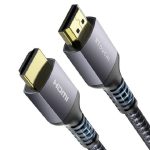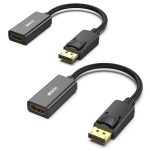In the intricate world of digital connections, HDMI and USB emerge as two dominant players, each with its unique capabilities and purposes. But which one is truly “better”? The answer, as you might expect, is not a simple one. The “better” choice hinges on your specific needs and the tasks you want to accomplish. Let’s embark on a comparative journey, exploring the strengths and weaknesses of HDMI and USB, to help you make informed decisions when connecting your devices.
Contents
- 1 Purpose and Functionality: Understanding the Core Difference
- 2 Audio and Video Transmission: Where HDMI Shines
- 3 USB: The Multifaceted Connector
- 4 Choosing the Right Interface: Matching Your Needs
- 5 Power Delivery: USB’s Unique Advantage
- 6 The Future of Connectivity: Emerging Trends and Possibilities
- 7 Conclusion
Purpose and Functionality: Understanding the Core Difference
At their core, HDMI and USB serve distinct purposes, each tailored to specific types of data transmission.
HDMI: The Audiovisual Maestro
High-Definition Multimedia Interface: HDMI is designed primarily for transmitting high-quality audio and video signals between devices. It’s the go-to connector for linking laptops, gaming consoles, Blu-ray players, and streaming devices to TVs, monitors, and projectors.
Uncompressed Digital Signals: HDMI supports uncompressed digital signals, ensuring high-fidelity audio and video transmission without any loss of quality.
Various Versions and Standards: HDMI has evolved over the years, with different versions and standards offering varying levels of performance and features, including support for higher resolutions, refresh rates, and advanced audio formats.
USB: The Versatile Connector
Universal Serial Bus: USB, on the other hand, is a more versatile interface, capable of transmitting data, power, and even video and audio signals, albeit with certain limitations.
Data Transfer and Device Connectivity: USB is widely used for connecting peripherals like keyboards, mice, printers, and external hard drives to computers. It also facilitates data transfer between devices.
Power Delivery: USB ports can also supply power to charge devices like smartphones, tablets, or cameras.
USB-C: The latest USB standard, USB-C, offers even greater versatility, supporting faster data transfer speeds, higher power delivery, and even video output through alternate modes.
Audio and Video Transmission: Where HDMI Shines
When it comes to transmitting high-quality audio and video signals, HDMI reigns supreme.
-
High-Definition Video: HDMI supports a wide range of resolutions, from standard definition to 4K and even 8K, delivering crisp and clear visuals for movies, games, and presentations.
-
High-Fidelity Audio: HDMI can carry multi-channel audio signals, including surround sound formats like Dolby Atmos and DTS:X, creating an immersive audio experience.
-
Audio Return Channel (ARC): HDMI ARC allows audio to be sent both ways between your TV and an audio device (e.g., soundbar) using the same HDMI cable, simplifying connections and reducing cable clutter.
-
Enhanced Audio Return Channel (eARC): eARC is an upgraded version of ARC that supports even higher-bandwidth audio formats, delivering a truly cinematic sound experience.
HDMI Advantages for Audio and Video:
- Superior Quality: HDMI delivers uncompressed digital audio and video signals, ensuring the highest possible quality without any loss or degradation.
- Single Cable Convenience: It combines audio and video transmission into a single cable, streamlining your setup and minimizing clutter.
- Wide Compatibility: HDMI is a widely adopted standard, making it compatible with a vast range of devices.

USB: The Multifaceted Connector
While HDMI dominates the audiovisual realm, USB’s strength lies in its versatility and adaptability across a wide range of applications.
-
Data Transfer: USB is primarily designed for data transfer between devices. It allows you to connect peripherals like keyboards, mice, printers, and external hard drives to your computer, facilitating seamless data exchange.
-
Device Connectivity: USB enables connectivity for a plethora of devices, from smartphones and cameras to gaming controllers and musical instruments. This versatility makes it an indispensable interface in the modern digital landscape.
-
Power Delivery: USB ports can also supply power to charge devices like smartphones, tablets, or even laptops. The latest USB-C standard supports even higher power delivery, allowing for faster charging of compatible devices.
-
Audio and Video Transmission (with limitations): While primarily a data and power interface, USB can also transmit audio and video signals through alternate modes like DisplayPort or Thunderbolt. However, its capabilities in this regard might be limited compared to dedicated HDMI connections, especially for high-resolution video or multi-channel audio.
USB Advantages:
- Versatility: USB’s ability to handle data, power, and even audio/video transmission makes it a truly versatile connector.
- Wide Compatibility: USB is a ubiquitous standard, found on virtually every computer and a vast array of other devices.
- Compact and Portable: USB connectors are generally smaller and more compact than HDMI connectors, making them ideal for portable devices.
Choosing the Right Interface: Matching Your Needs
The ideal choice between HDMI and USB depends entirely on your specific needs and the tasks you want to accomplish.
-
Audio and Video: If your primary goal is to transmit high-quality audio and video signals between devices, HDMI is the undisputed champion. Its high bandwidth, uncompressed digital transmission, and support for advanced features like 4K resolution, HDR, and surround sound make it the preferred choice for home entertainment, gaming, and presentations.
-
Data Transfer and Device Connectivity: If you need to connect peripherals, transfer data between devices, or charge your gadgets, USB is the more versatile and practical option. Its widespread adoption and ability to handle both data and power make it an essential interface for everyday computing and connectivity.

Hybrid Solutions: Bridging the Gap
In some cases, you might need to combine the benefits of both HDMI and USB. Thankfully, adapters and converters are available to bridge the gap between these two interfaces.
USB-C to HDMI Adapters
If your laptop or device has a USB-C port with DisplayPort or Thunderbolt alternate mode support, you can use a USB-C to HDMI adapter to connect to an HDMI display.
HDMI to USB Capture Cards
These devices allow you to capture HDMI video and audio signals and convert them into a format.
Power Delivery: USB’s Unique Advantage
One area where USB shines is its ability to deliver power to connected devices, a feature not offered by HDMI.
Charging and Powering Devices
USB ports can supply power to charge or operate a wide array of devices, from smartphones and tablets to cameras.
USB-C Power Delivery
The latest USB-C standard supports even higher power delivery, up to 100W, allowing you to charge even power-hungry devices.
Eliminating the Need for Separate Chargers
This power delivery capability can simplify your setup and reduce the number of cables and chargers you need to carry.
The Future of Connectivity: Emerging Trends and Possibilities
As technology continues to evolve, we can expect advancements in both HDMI and USB, blurring the lines between their capabilities.
-
Thunderbolt: Thunderbolt, a high-speed interface that combines data, video, is emerging as a powerful contender in the connectivity. It offers even higher bandwidth than HDMI and USB, enabling faster data transfer speeds and support for multiple 4K displays.
-
Wireless HDMI: While wireless HDMI solutions exist, they currently face limitations in terms of range and bandwidth. However, advancements in wireless technology might make them a more viable and popular option in the future.
-
USB4: The latest USB standard, USB4, promises even faster data transfer speeds and enhanced video and audio capabilities, potentially bridging the gap between HDMI and USB even further.

Conclusion
In the HDMI vs. USB debate, there’s no single “better” option. Each interface excels in its specific domain, catering to different needs and applications. HDMI reigns supreme for high-quality audio and video transmission, while USB offers versatility for data transfer, device connectivity, and power delivery.
By understanding the unique capabilities and limitations of each interface, you can make informed choices about which one to use for connecting your devices. Whether you’re enjoying a movie on the big screen, transferring files between devices, or embarking on a creative project, the right connection can make all the difference in your digital experience.


